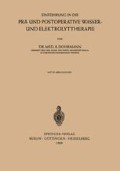Zusammenfassung
Jede Operation ruft eine Reaktion des Organismus hervor, deren Ausmaß von der Größe des Traumas und der „Ausgangslage“ des Patienten abhängt. Leriche hat 1934 für die Gesamtheit der Symptome den Begriff der „maladie postopératoire“ geprägt und unterscheidet die örtlichen Erscheinungen — lokale Hitze, Hyperämie, Ödem und Leukocytenansammlung — und die allgemeinen Zeichen — Durst,Trockenheit der Zunge, Brechreiz, Blässe, Schwäche, muskuläre Hypotension, Azotämie und Oligurie.
Access this chapter
Tax calculation will be finalised at checkout
Purchases are for personal use only
Preview
Unable to display preview. Download preview PDF.
Author information
Authors and Affiliations
Rights and permissions
Copyright information
© 1959 Springer-Verlag oHG. Berlin · Göttingen · Heidelberg
About this chapter
Cite this chapter
Dohrmann, R. (1959). Einfluß der Operation auf den Wasser- und Elektrolythaushalt. In: Einführung in die Prä- und Postoperative Wasser- und Elektrolyttherapie. Springer, Berlin, Heidelberg. https://doi.org/10.1007/978-3-642-49191-7_2
Download citation
DOI: https://doi.org/10.1007/978-3-642-49191-7_2
Publisher Name: Springer, Berlin, Heidelberg
Print ISBN: 978-3-540-02375-3
Online ISBN: 978-3-642-49191-7
eBook Packages: Springer Book Archive

